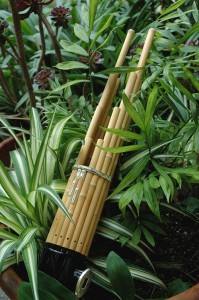Birth and History of a small instrument : The Harmonica
We are in China, in the 27th century BC,under the reign of one of the " Great three ancestors ", the emperor Huàngdi, the " Yellow King ", who lived, according to the legendary history, from 2697 to 2597 B.C. With the inventions of the compass, of the chinese calendar, of oceanic boats, armours and of ceramic, he is also credited with the invention of the sheng, first instrument with free reeds, based upon the two fundamental principles governing the universe : the yin, female and passive, and the yang, male and active.
" Yin and yang are musically related and tuning in harmony, said Houàngdi, that's why we recognize in music the supreme truth to which the body, the mind, the human society and the whole universe are obeying. The five music notes are corresponding to everything that can be seen on earth : colors, seasons, elements, planets. To the note Kyo is corresponding our liver, to Tche is corresponding our heart, to Kong our spleen, to Chang our lungs, and to Yu our kidneys. Music is the remedy for our body and soul aches. It is also the supreme key to wisdom. Human being, like everything in the Universe, is a chord of the Great Symphony. " ( " Harmonica Book " Albert Raisner, 1961, Ed. Presses du Temps Présent, out of print).
It should be noted that the above mentioned five notes of the sheng, are in order : E, A, D, G, C, pentatonic scale. Consequently, this scale is the first important step taken on our earth by human music.

But it will only be in 1990 that pentatonic harmonicas are going to be created in Japan, by Juko Saito for " Tombo Company ", also manufacturing a re-creation of the sheng.
Let's go on travelling through time.
1295 AD, Marco Polo coming back from China, brings the sheng to the West ;
Marin Mersenne (1588-1648), French scientist, corresponding with Descartes, Pascal, Toricelli, studies the sheng in great detail and introduces the free reeds principle in Europe. This helps him to determine the frequencies ratio of the notes scale ;
1796, Father Amiot, missionary priest, brings back from China to Paris several shengs ;
1780, in different places in Europe, instrumental experiences based on the study of free reeds are conducted ;
1816, a german organ builder, Johan Buschmann invents the terpodion, keyboard with free reeds, which is predecessor to the harmonica and the harmonium ;
1821, his son, Christian Friedrich Buschmann takes out a patent on an harmonica he names aura. In 1828, he will write to one of his friends : " I have invented, in Barmen, a new very strange instrument.This small device is four inches diameter. It has twenty one notes. You can play piano, crescendo or ad libitum. It has no keyboard, it produces harmonies with six notes, fast or other movement. The sound can be hold as long as you are blowing it. My invention is aiming at playing the accompaniment with our instrument (terpodion) and the melody with the small device, this giving a very surprising effect. "
1825, birth of the first twenty notes/ten holes. A new configuration developed by a man called Richter, born in Bohemia (Czechoslovakia). Configuration used more and more, named after him : Richter diatonic. It will experience quite a revolution by the end of the 20th century with the discovery of overblows, (Howard Levy) and other bendings ;
1827, in France, in his workshop rue des Blancs Manteaux in Paris, Marie Candide Buffet, tuner, creates the metallic mouth harmonica. The manufacturing of it expands so quickly that he must share the production with private people, and among them, Jacob Alexandre who, in 1828, will have his own workshop specialized in manufacturing the same products.
They are so original and of so good a quality that Cyril Demian, Austrian, may be drawing inspiration from them, creates his hand harmonica or accordion, and takes out a patent in Vienna on the 6th of May 1829. After many improvements it will become the accordion we know to-day. The same year in Great Britain, Charles Wheatstone invents a small hexagonal instrument similar to the accordion, the concertina, thus changing the mouth symphonium, his first invention, in a bellows symphonium. In a way, we might say that the accordion would not be born at that time without the invention of the harmonica.
1827, Christian Messner, watchmaker in Trossingen, Germany, begins manufacturing in small quantities harmonicas Mundharfe model, with the help of his cousin Christian Weiss ;
1829, beginning of the first mass production, in Vienna, Austria.
- 1847, Christian August Seydel started his harmonica production factory in Klingenthal, Germany. This company is still alive nowadays.
1857, beginning of the Hohner saga, with Matthias Hohner producing the first year 650 harmonicas. Hohner S.A. will produce its thousand millionth harmonica in 1986 with the model Comet.
Did you know that the first famous harmonicist to be listed in 1860, was Abraham Lincoln ? We couldn't find a better symbol to begin the human adventure of our instrument.
At the end of the 19th century, in the USA, country music pionners are going to take a major part in the harmonica development, as a result of the emigration of people from across the Atlantic melting there their original traditions : Anglo-Irishes, Spanishes, Franco-Acadians, Poles and other people from Central Europe. They were bringing in their travel bags the first Hohner diatonic harmonicas ; the black population discovered the instrument and adopted it straight away. But they will always distance themselves from the country music, knowing only the hardline blues culture.
At the beginning of the 20th century, Japan will know in its turn an impressive take off with Hidero Sato who is going to marry the tremolo harmonica with the traditional japanese instruments : koto, shamizen, sakuhashi and various percussion instruments. So much that, nowadays, the tremolo has become a totally traditional instrument in many Far East countries.
In 1927, Hidero Satoh will receive the Jury Special Award in Trossingen, for his whole work. Today he is still the idol of millions of asian harmonicists .
Over the years, other types of harmonicas are going to come out that will bring different styles enriching our instrumental range. Apart from the above listed models, successively will appear
the chromatic harmonica and then the accompaniment harmonicas : the vinetta, the wellknown polyphonia with its three branches, the black bass, then the white bass, the chord and more recently the harmonetta. (We will give you the technical characteristics of these instruments in the instrumental pages of our website).
The beginning of the 20th century will see the birth of legendary players who are going to give our instrument its illustrious history. We owe them to be there today. Among many more we can name : Larry Adler, Tommy Reilly, John Sebastian, Sonny Boy Williamson, Sonny Terry, Little Walter, Borrah Minevitch (the best and unrivalled), Jerry Murad and his Harmonicats... with the recording of " Peg O my Heart " brought out at eight million copies !
During the fifties, glorious years, the harmonica becomes very popular. Trios are a trend : Stagg Mc Mann, Raisner, Marny, Harmonicats, Hotcha, Candido as well as new chromatic soloists completing the range : Jean " Toots " Thielmans, Jean Wetzel, Dany Kane, Claude Garden, René Gary, Franco de Gemini, they have recorded many film music such as the famous " Touchez pas au Grisbi ". Franco Gemini holds the record in this category with, for him alone, eight hundred film musics.
Many great composers have been interested in our instrument. Many classical pieces (concertos, etc.) have been written by famous names : Darius Milhaud, Villa Lobos, Sauguet, Dutoit, Piazzola, Dompierre, etc. Gerschwin and Ravel were enthusiastic about Larry Adler interpretations of the " Rhapsody in Blue "and of the " Boléro ".
Were reaching the end of this chapter of the past history and of what we must remember about it.
The sixties are our time. It's up to us to build the history of today mouth music and to pass it to the future, without letting the past sink into oblivion.
This page is amply developed in the Harmonica Encyclopedia I am writing. I'll later inform you of the publication date.
- Jean Labre
Photos: M. Vicent-Roubert and Harmonikamuseum Trossingen
Published January 16th 2006
|

